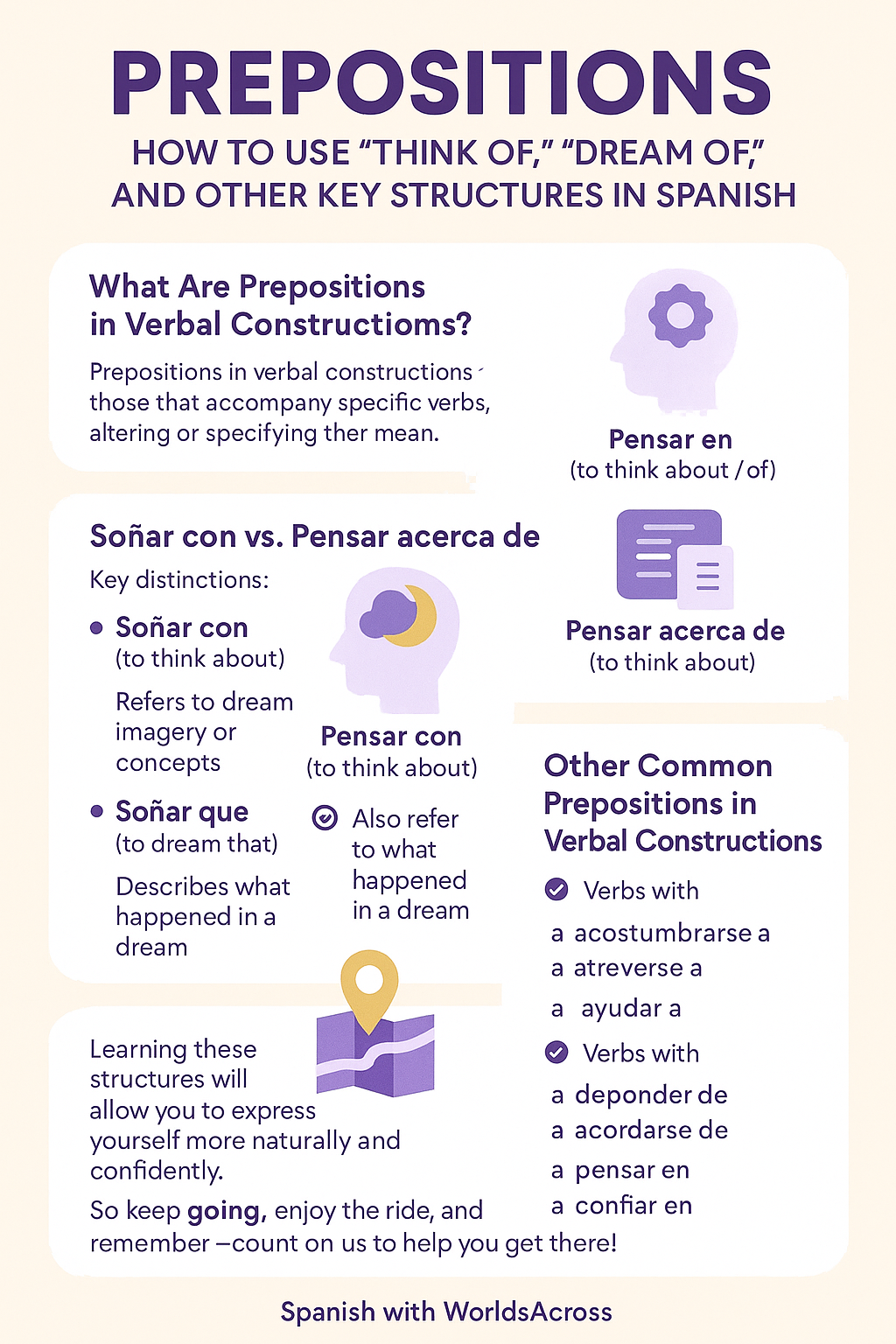How to use “pensar en”, “soñar con”, and other key structures
If you’ve ever wondered why in Spanish we say “confiar en” instead of “confiar de”, or why it’s “soñar con” and not “soñar de”, this article is for you. These are prepositions in verbal constructions (preposiciones en régimen verbal): small words that transform the meaning of verbs and help us express ourselves more precisely.
In this article, we’ll explore how they work, why they matter, and how to use them correctly. Plus, you’ll learn common structures that will help you speak more fluently.

What Are Prepositions in Verbal Constructions?
Prepositions in verbal constructions are those that accompany specific verbs in a fixed way, altering or specifying their meaning. In Spanish, certain verbs require a specific preposition for the sentence to make sense. You can’t just swap them out without changing or losing meaning.
For example:
- “Pensar en” (to think about/of) refers to an idea, person, or situation someone is focused on.
- “Soñar con” (to dream of/about) expresses both literal dreams and personal aspirations.
In Spanish, correct preposition use is essential to build grammatically sound sentences. Omitting or changing them can cause confusion. That’s why learning these structures is key to speaking Spanish just the way you want to.
“Pensar en” vs. “Pensar acerca de”

These two expressions may seem similar, but they’re used differently.
“Pensar en” (to think of/about)
Used when someone focuses their attention on a specific topic, person, or situation.
Examples:
- “Pienso en mis vacaciones todo el tiempo.”
(I think about my vacation all the time.) - “Siempre pienso en mis metas y cómo alcanzarlas.”
(I always think about my goals and how to achieve them.)
Use: Indicates a spontaneous or recurring thought.
“Pensar acerca de” (to think about)
Used in more formal contexts or when analyzing a topic in depth.
Examples:
- “He estado pensando acerca de lo que hablamos ayer.”
(I’ve been thinking about what we talked about yesterday.) - “Hemos estado pensando acerca de las consecuencias de la inteligencia artificial.”
(We’ve been thinking about the consequences of artificial intelligence.)
Key difference: Pensar en is more casual and used in everyday conversation, while pensar acerca de is more academic or formal.
“Soñar con” vs. “Soñar que”

This verb also has key distinctions:
“Soñar con” (to dream about) + noun
Used to describe images or situations that appear in dreams.
Example:
- “Anoche soñé con un bosque encantado.”
(Last night I dreamed about an enchanted forest.)
Use: Refers to dream imagery or concepts.
“Soñar que” (to dream that) + complete sentence
Describes a specific action within the dream.
Example:
- “Soñé que volaba sobre un bosque encantado.”
(I dreamed that I was flying over an enchanted forest.)
“Soñar con” in a figurative sense
It also refers to goals or life aspirations.
Example:
- “Siempre he soñado con viajar por el mundo.”
(I’ve always dreamed of traveling the world.)
Key difference: Use soñar con for dreams and aspirations, and soñar que to describe what happened in a dream.
Other Common Prepositions in Verbal Constructions
Preposition use in Spanish isn’t limited to a few verbs—there are many important combinations to know.
Verbs with “a”
- “Acostumbrarse a” → “Me estoy acostumbrando a mi nuevo trabajo.”
(I’m getting used to my new job.) - “Atreverse a” → “No me atrevo a saltar desde aquí.”
(I don’t dare to jump from here.) - “Ayudar a” → “Te ayudaré a terminar el informe.”
(I’ll help you finish the report.)
Verbs with “con”
- “Soñar con” → “Siempre sueño con viajar por el mundo.”
(I always dream about traveling the world.) - “Contar con” → “Siempre puedes contar con mi apoyo.”
(You can always count on my support.)
Verbs with “de”
- “Depender de” → “El éxito depende de tu esfuerzo.”
(Success depends on your effort.) - “Acordarse de” → “Me acordé de llamar a mi mamá.”
(I remembered to call my mom.)
Verbs with “en”
- “Pensar en” → “Pienso en ti todo el tiempo.”
(I think about you all the time.) - “Confiar en” → “Confío en mis amigos.”
(I trust my friends.)
These structures show that prepositions in verbal constructions are fundamental to Spanish. Learning them will allow you to express yourself more naturally and confidently.
In conclusion, mastering preposition use in Spanish is like finding the key to speak smoothly and accurately. It’s not just about grammar rules—it’s about putting the right pieces in the right place so your Spanish sounds authentic.
Each verb has its ideal match, and learning these combinations will help you avoid mistakes and communicate like a native speaker. At first, prepositions in verbal constructions might seem like a challenge, but with practice, they become as intuitive as riding a bike.
Think of this as a language map: the more you explore it, the easier it becomes to move without getting lost. So keep going, enjoy the ride, and remember—every correctly used word gets you one step closer to fluency. Count on us to help you get there!



